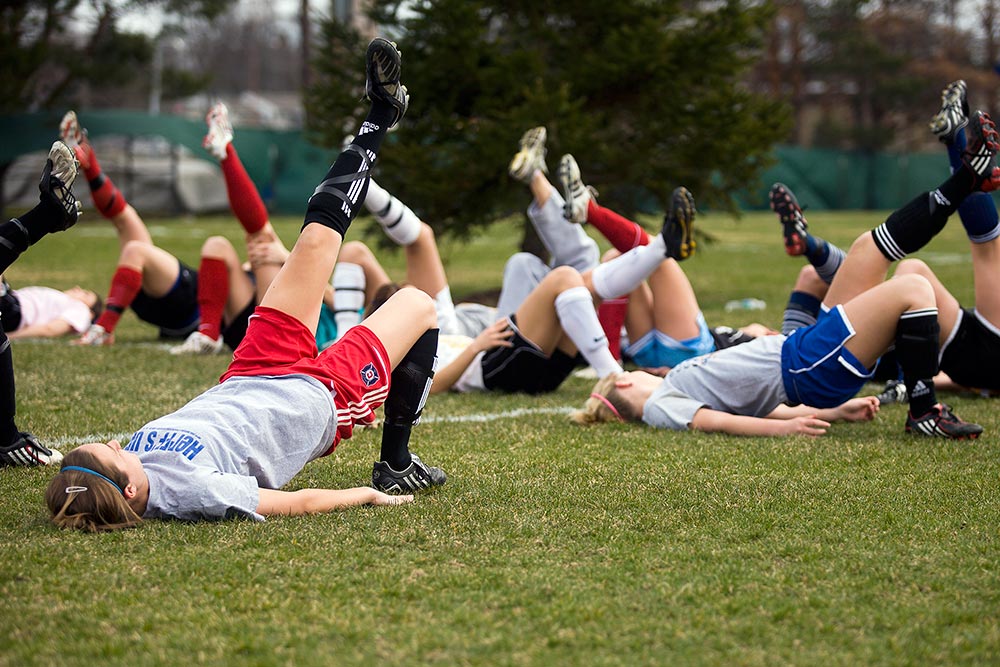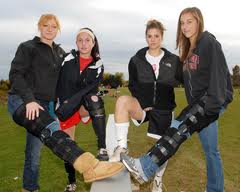This is part 1 of a 2 part series.

Anterior Cruciate Ligament (ACL) injury is a very common and extremely debilitating injury occurring in both male and female athletes. Unfortunately, due to various factors, female athletes are much more likely to suffer injury to the ACL. Studies suggest that female athletes are four to six times more likely to injure their ACL than male counterparts taking part in similar activities. Various theories exist as to why females are at greater risk, including non-modifiable (e.g., wider bony pelvic anatomy, hormonal factors) and modifiable risk factors.
What is the ACL and why is it so important?
The ACL is one of the four main stabilizing ligaments of the knee. It is located in the center of the knee, attaching the femur (thigh-bone) to the tibia (shin-bone). The ACL traverses from a posterior, or rear, attachment on the femur, to an anterior, or forward position on the tibia. “Anterior” refers to the position of the ACL in respect to its counterpart, the Posterior Cruciate Ligament, which lies directly behind the ACL. “Cruciate” (latin for “cross”) refers to the orientation of the two ligaments with respect to one another. Due to the position of its attachments, the ACL plays a role in preventing anterior translation, or excessive forward movement, of the tibia on the femur. Athletes with ACL-deficient knees often experience “giving-out” or instability of the knee, especially during activities that involve twisting or pivoting, such as soccer, basketball or volleyball.
 The orthopedic physical therapist frequently works with patients who have suffered injury to the ACL and have undergone surgical reconstruction (ACLR) of the ligament. Immediately after surgery, several critical factors need to be addressed to allow optimal healing and recovery of function. Among these is restoration of full extension, or straightening, of the knee. Early stage ACLR rehabilitation protocols are well documented in the research. However, later phase rehabilitation of the patient having undergone ACLR is often lacking, failing to address some of the important modifiable factors that have been identified as causative with respect to ACL injury. In fact, individuals who have undergone ACLR have a one in four chance of injuring either the surgically repaired knee or the opposite knee, compared to the 1:50-100 likelihood affecting those participating in similar activities.
The orthopedic physical therapist frequently works with patients who have suffered injury to the ACL and have undergone surgical reconstruction (ACLR) of the ligament. Immediately after surgery, several critical factors need to be addressed to allow optimal healing and recovery of function. Among these is restoration of full extension, or straightening, of the knee. Early stage ACLR rehabilitation protocols are well documented in the research. However, later phase rehabilitation of the patient having undergone ACLR is often lacking, failing to address some of the important modifiable factors that have been identified as causative with respect to ACL injury. In fact, individuals who have undergone ACLR have a one in four chance of injuring either the surgically repaired knee or the opposite knee, compared to the 1:50-100 likelihood affecting those participating in similar activities.
Timothy Hewett, PhD, of the Cincinnati Children’s Hospital Medical Center, and his colleagues, have generated valuable research addressing the modifiable factors placing female athletes at greater risk for ACL injury. Their work has identified the following variables:
- Ligament Dominance – refers to the inability of the muscular system to attenuate, or absorb, forces adequately, placing greater stress on the ligamentous structures of the knee, specifically the ACL.
- Quadriceps Dominance – females have a greater tendency to fire the quadriceps in jumping/landing tasks, leading to a position of decreased knee flexion (bending), placing greater strain on the ACL.
- Leg Dominance – females typically show greater asymmetry between leg strength and recruitment patterns in tasks demanding side-to-side activity, creating a situation where more load is applied to a single leg, again placing the individual at greater risk for injury.
- Trunk Dominance–various studies have found females to have decreased proprioception (the body’s ability to sense position in space) of the torso compared to males. Females also lack the same “neuromuscular spurt” that males experience following the adolescent growth spurt, resulting in less trunk strength and power. The end result of trunk dominance is that in females, the center of mass is more likely to fall outside the axis of the knee, forcing the knee inward toward the other (“valgus” motion) – a position of extreme load and risk for the ACL.
These four factors, when combined, often result in a familiar athletic scenario: the female athlete landing from a jump, primarily on one leg (leg dominance), the torso leaning excessively toward that side (trunk dominance), a relatively straight knee (quadriceps dominance), and a forceful inward or valgus positioning (ligament dominance) of the same knee.
The role of the orthopedic physical therapist is to identify these risk factors, and if present, address each with appropriate training and exercises. Research suggests that treatment programs addressing these factors can successfully reduce the risk of re-injury in those who have undergone ACLR and are returning to sports.
The second article in this series will investigate physical therapy interventions to address the modifiable ACL risk factors among females, and discuss appropriate ways to determine readiness for return-to-sport for the athlete having undergone ACLR.
References:
Hewett, T, et al. “Understanding and preventing ACL injuries: Current biomechanical and epidemiologic considerations – Update 2010”. North American Journal of Sports Physical Therapy.Dec. 2010, 5: 234-251.

